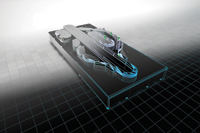
Posted to News on 23rd Oct 2019, 00:00
Digital twins revolutionise time to market for machines
How long it takes to develop a machine's hardware and program its software can be a decisive factor in its success or failure against the competition. Digital twins can play an important role in rapid development and testing.

The only way for machines to achieve their ever tighter development schedules is with highly efficient processes. Errors must be ruled out from the start rather than corrected after the fact. Even the prototype of a new machine has to be right the first time. “To meet these lofty targets, simulation is an approach that has proven itself in many different disciplines,” says Kurt Zehetleitner, responsible for simulation and model-based development at B&R. A digital twin makes it possible to evaluate the characteristics of a product before any part of it actually exists.
This approach is already common practice for developing the mechatronic systems used in the automotive and aviation industries. Mechanical systems are modelled on the computer and tested in a simulation environment. This development strategy is still gaining a foothold in other areas of manufacturing. This can be largely attributed to the widespread misconception that developing simulation models is a time-consuming task that can only be performed by developers with a strong understanding of advanced mathematics, and that models themselves are prone to errors. “That may have been the case early on,” says Zehetleitner, “but today, creating simulation models is considerably easier and faster.”
Today’s simulation tools make it very easy to generate digital twins. Not only does this simplify and accelerate hardware and software development, it also makes it possible to perform virtual commissioning. Simulating the physical behaviour of a machine in real time makes it possible to identify bottlenecks and potential for optimisation very early in development. “With seamless interaction between development tools, simulation facilitates a high degree of flexibility and efficient resource management,” says Zehetleitner. “This contributes to optimal utilisation of development resources and helps reduce commissioning times by up to 80%.”
In the B&R Automation Studio engineering environment, a digital twin gives application developers a decisive advantage – they can start up the virtual model directly on the PC and connect to the machine controller in a software- or hardware-in-the-loop configuration. The application software can be developed, verified and tested in advance, and performance requirements can be tested on the controller. To create a digital twin, the developer imports the CAD data for the machine into a modelling tool, such as MapleSim. They can easily use important characteristics from the CAD design, like mass and density values, and can also provide individual mechanical components with additional properties, like degrees of freedom and an interface to the controller.
With tools like MapleSim and industrialPhysics, even complex models are easy to implement. MapleSim offers a library of modelling elements like masses, joints, springs and dampers that make the process of expanding and fine-tuning a model intuitive and easy. The system generates the equations for the model in the background. A B&R app in MapleSim allows the model to be automatically exported to Automation Studio, along with the CAD data. There, users can test the machine software with regard to motor load and controller tuning. B&R’s Scene Viewer tool uses the provided CAD data to visualize movements in 3D. “This makes testing and troubleshooting very easy for the software developer,” says Zehetleitner.
The approach is similar with the industrialPhysics simulation tool. The tool has an integrated physics engine that provides an approximate simulation of physical systems with an emphasis on real-time performance. “It’s this type of system that now makes it possible to simulate entire machines and plants,” says Zehetleitner. “You can even verify the real-time behaviour and the system load on the target hardware in a hardware-in-the-loop environment.”
Once the digital twin has been created, automatic code generation plays an important role in the development and implementation of machine functions on the target system. Among the many benefits, it substantially reduces the amount of programming required. The MATLAB/Simulink tool is particularly well suited for automatic code generation. B&R has developed a bidirectional interface between MATLAB/Simulink and Automation Studio. With Automation Studio Target for Simulink, the developer’s work is reduced to only a few mouse clicks.
“They can get very quickly from creating a model in Simulink to running high-quality program code on the B&R controller,” says Zehetleitner, “including some very sophisticated diagnostic options.” Automation Studio Target for Simulink helps achieve high product quality while at the same time significantly accelerating the development of machine software.
When working with simulation tools, open standards and interfaces are essential to allowing the different systems involved to communicate freely and seamlessly. The ability to use existing software also saves valuable time. B&R offers openness on all levels and in all products. With the independent industrial standard Functional Mock-up Interface (FMI), models can be exchanged and co-simulated using a variety of development tools. B&R offers a mechanism for importing Functional Mock-up Units (FMU) in accordance with the FMI 2.0 standard. “FMUs are seamlessly integrated into Automation Studio as function blocks,” explains Zehetleitner.
Simulation tools can be used to test models in all defined scenarios and perform comprehensive virtual commissioning. Testing performed during virtual commissioning can range from simple logical sequences to complex, critical scenarios to ensure the overall efficiency and quality of the machine's hardware and software. Using a digital twin drastically reduces the amount of time needed to commission the actual machine and minimises the risk of errors.
B & R, Southgate Park, Bakewell Road
Broadoak
Orton Southgate
PE2 6YS
United Kingdom
+44 (0)1733 371320






